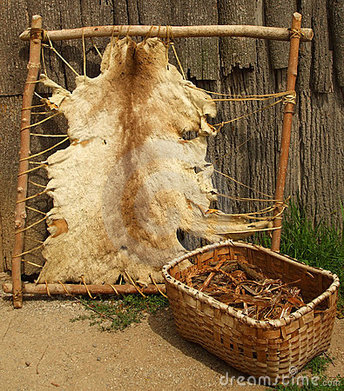|
Leather Technology
Jean Vaucher (August 2022) |
- Index
- Introduction
- Stone tools
- Cordage & Basketry
- Mastery of Fire
- Leather & Animal resources
Leather
There are two steps to using animal skins: first skinning and drying to get rawhide; then tanning to get leather.Rawhide
- Start off by skinning the animal and spread the skin out so there are no folds or creases.
- Next, scrape as much mucus and membrane off the inside of the skin as you possibly can, then dry the skin out in the air and sun.
- Cover the skin with an inch or so of dry dirt over it. Gently force in the dirt with repeated, light strokes, then remove the dirt and replace it with fresh dry dirt.
- Adding and removing several coatings of dirt helps get the skin cleaned and dried.
- To make leather rope, cut the hide into thin strips, tie the strands together to get the length you need, then wet it a bit and apply it to whatever you’re going to tie or lash together. When the skin dries, it becomes very hard and strong.
Leather
- For primitive tanning, it turns out that each animal's brain contains all you need to make supple, long lasting items.
- As above, scrape off all flesh, fat and fur. For furry items, remember to scrape all the flesh off on the inside only. Otherwise, you must scrape both sides.
- Then make a slurry with water and the cut-up brain. Soak the skin in the slurry until it feels like cooked pasta. Play with it, stretch it, scrape it some more, and let it sit a day or two in the slurry. Next rinse it and let it almost dry.
- While it is still pliable, scrape it some more, and work it over a piece of log or stone like you were buffing your shoes with it. Do this until the leather is soft and supple. The eskimos used to chew the skins.
- Hide Materials, Wikipedia
- Native tanning, North America
- Brain tanning, North America
- The History of Leather Tanning
- Iroquois clothing
Five short films on how reindeer carcasses were processed with Neolithic tools for the skin, bones, antlers etc. [ Kierikki Stone Age Centre, 2014 ]
- Carcass Processing
- Tanning, featured above
- Tendon String
- Bone Needle
- Sewing
